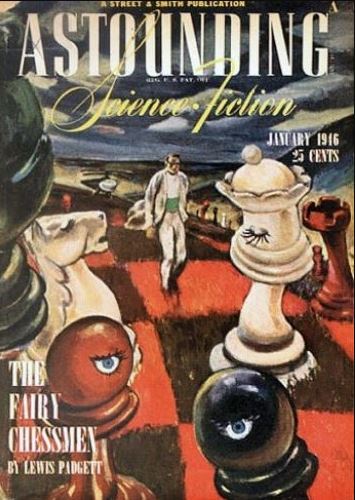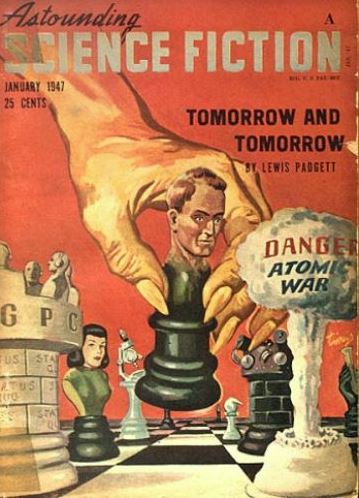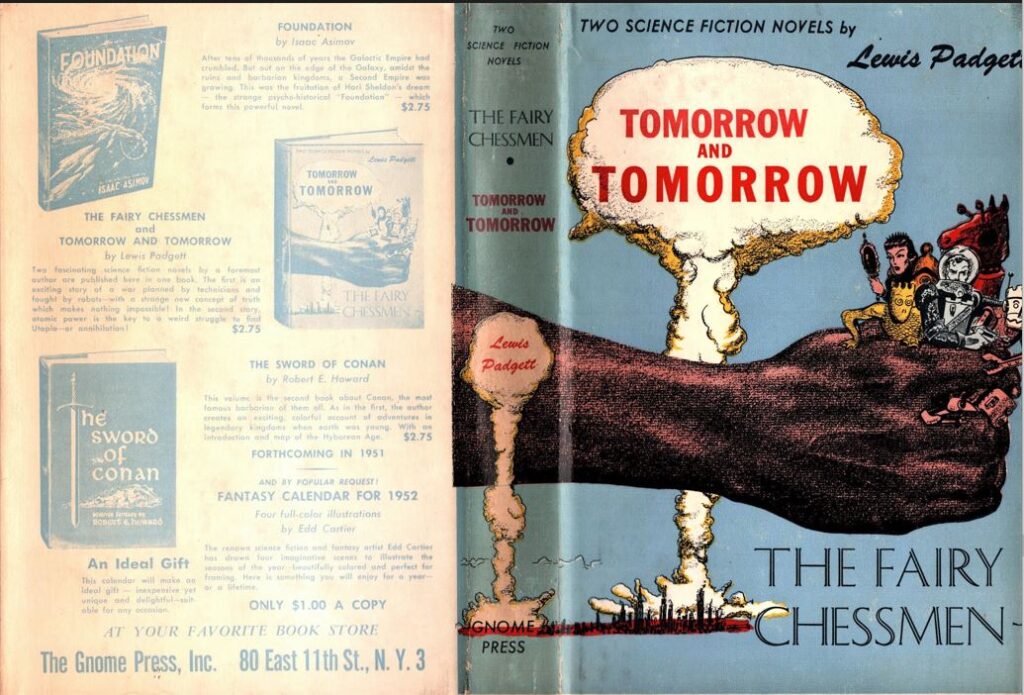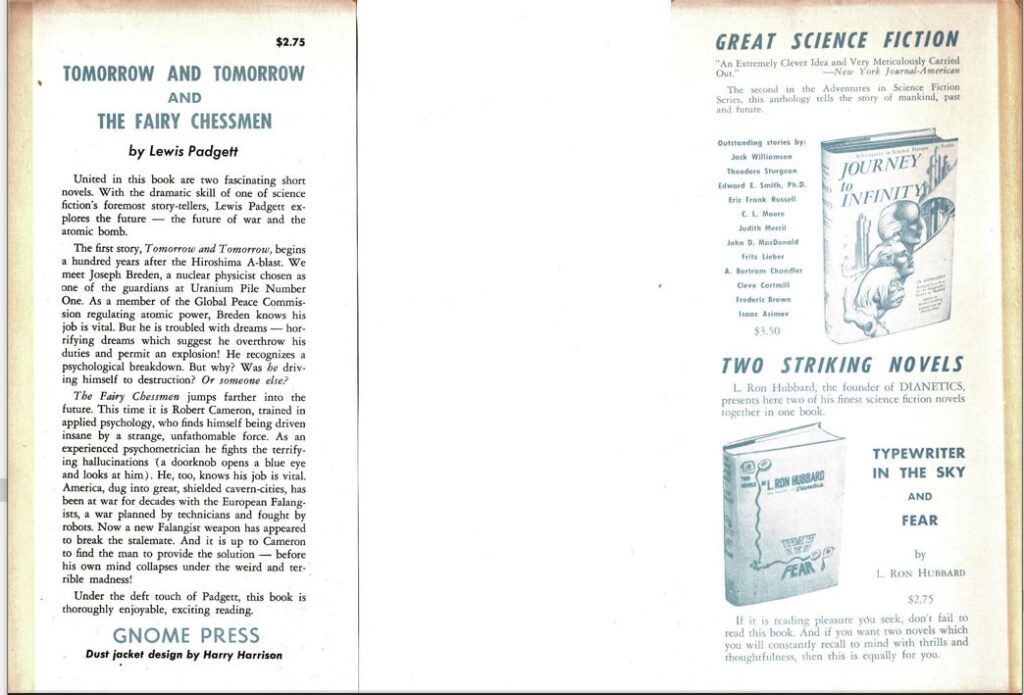Comments
“Lewis Padgett” is the pseudonym used by the husband and wife team of Henry Kuttner (1915-1958) and Catherine Lucille “C. L.” Moore (1911-1987) for their prestige stories sold to John W. Campbell and published in Unknown and Astounding, the first one being “A Gnome There Was” in the October 1941 Unknown Worlds. (For their solo careers, see Robots Have No Tails for Kuttner and Judgment Night for Moore. Kuttner’s last work is covered in SF:57.) Moore was a slow writer, crafting her stories; Kuttner was a dervish, always flinging out ideas as fast as his fingers could strike the keys. They balanced each other to keep a steady stream of superior stories flowing.
The two married on June 7, 1940, four years after Kuttner sent a fan letter to Mr. Moore and was amazed to receive a reply signed Catherine. She lived in Indianapolis; he in Los Angeles, stopping in to see her on trips to New York. Their collaboration began during the courtship: the first joint story is “Quest of the Starstone”, a Jirel of Joiry story in the November 1937 Weird Tales under both their names. Thus began the coming bibliographic nightmare. Moore wrote as Moore, but not always; Kuttner wrote as Kuttner, but added pseudonyms; Kuttner and Moore wrote as Lewis Padgett, Lawrence O’Donnell, C. H. Lidell, and Keith Hammond and many more outside the field; stories with both their true names did not appear in genre magazines until late in their career. (“Earth’s Last Citadel,” however, appeared as a 1943 serial in Argosy under both names.) They famously would leave a story in the typewriter with a sentence half-written and the other would take over seamlessly. But the prodigiously prolific Kuttner might also finish a story by himself and send it out under the Padgett name and a few Moore stories were published as by O’Donnell. I doubt that they could consistently tell you whose work was whose and we only know details about a few stories by accident. “Lewis” was Kuttner’s mother’s maiden name; “Padgett” was Moore’s grandmother’s maiden name. John W. Campbell revealed that the pseudonym was Kuttner’s as early as 1943 but Moore’s name seemingly wasn’t referenced as a contributor until after WWII.
The ISFDB ascribes The Fairy Chessmen and Tomorrow and Tomorrow, both published in post-war Astoundings under the Padgett pseudonym, to both Kuttner and Moore, and so did later reprintings of the stories. If that was supposed to be a secret to the contemporary general public, readers of fanzines had better information. The April-May 1947 issue of Fantasy Review spoke of “Henry Kuttner and wife C. L. Moore, writing as Lewis Padgett and Lawrence O’Donnell” in an off-hand manner, not in any way revealing startling information. Why then did contemporary reviews of Tomorrow by ultimate insiders Sam Merwin Jr., Damon Knight, and P. Schuyler Miller state flatly that Padgett is a pseudonym for Kuttner, without any mention of Moore? Did they have inside information about these stories’ origins?
Or perhaps they were willfully blind. Ray Bradbury wrote a paean to Kuttner for the Introduction to The Best of Henry Kuttner, a posthumous collection from 1975. Nowhere in it is Moore’s name mentioned. For that matter, nowhere in it is Padgett’s name mentioned, even though most of the stories were published under that name.
Gnome Notes
Similarly, although the front flap on Tomorrow refers solely to Lewis Padgett, the other-books-by page lists three Padgett books (two mysteries and the collection A Gnome There Was) and also Fury by Henry Kuttner. Yet Fury first appeared as by Lawrence O’Donnell and all the stories in the collection had been originally published under the Padgett joint name. The stories “A Gnome There Was” and “Exit the Professor” later appeared in the collection No Boundaries credited to and copyright by both Kuttner and Moore, so there can be no doubt of their joint origin, and there is little reason to doubt it for any of the other stories. The ISFDB notes in its entry for Fury that “According to Moore’s introduction in the Magnum/Prestige Books edition of the book, Moore wrote about one eighth of the text,” so her name should have been mentioned with Kuttner’s. No one seems to know why the open secret was still being kept. Improbably, Moore had never appeared in a book published under her name, and so no books were available for Greenberg to tout. To his credit he would soon publish the first three Moore books of her career, all collections. With the two Padgett collections and a solo Kuttner collection, Gnome published a total of six books by the couple, more than by any other single author. (Robert E. Howard’s original material appeared in only five of the seven Conan volumes.)
The dust jacket cover reads “Two Science Fiction Novels” as does the jacket spine. The boards spine merely puts Tomorrow and Tomorrow over The Fairy Chessmen with an atom symbol in the middle, while the jacket spine has The Fairy Chessmen on top, separated by a dot from Tomorrow and Tomorrow. The back panel calls it The Fairy Chessmen and Tomorrow and Tomorrow, consistent with the adjacent spine. My preference has been to favor the title page over just jackets, and the title page reads Tomorrow and Tomorrow and The Fairy Chessmen.
Yes, that is the writer Harry Harrison who did the cover art. He started out as an artist and gradually moved over to stories because his cover art was none that good. This is the one of only two covers he is credited with (the other was for a much later British edition of one of his novels), although he did a dozen or so interior illustrations for magazines in 1951 and 1952. The rear cover and the rear flap are printed in a nearly unreadable light blue ink, but the front flap had the standard black ink. A production mistake or a bad decision on Dave Kyle’s part? Either way, one of the least aesthetically successful Gnome books.
Reviews
Sam Merwin Jr., Amazing Stories, April 1952
The two novellas or short novels or whatever that make up this new volume represent two of the Mr. Kuttner-Padgett’s more closely-worked and ingenious efforts.
Unsigned, Oakland Tribune, January 27, 1952
These stories are not, unfortunately, up to the standards Mr. Padgett set himself in his collection of short stories, “A Gnome There Was.”
Contents and original publication
• “Tomorrow and Tomorrow” (Astounding Science Fiction, January and February 1947).
• “The Fairy Chessmen” (Astounding Science Fiction, January and February 1946).
Bibliographic Information
Tomorrow and Tomorrow and The Fairy Chessmen, by Lewis Padgett (pseud. of Henry Kuttner and C. L. Moore), 1951, copyright registration 1Dec51, Library of Congress Catalog Card Number none [51-14785], title #17, back panel #16, 254 pages, $2.75. 4000 copies printed. Hardback, dark gray boards, spine lettered in black. Dust jacket design by Harry Harrison. “FIRST EDITION” on copyright page. Printed and bound in the United States of America by H. Wolff and designed by David Kyle. Title page, jacket, and copyright registration add “Two Science-Fiction Novels.” Back panel: 3 titles plus 1952 Fantasy Calendar. Gnome Press address given as 80 East 11th St., N.Y. 3.
Variants
None known.
Images






